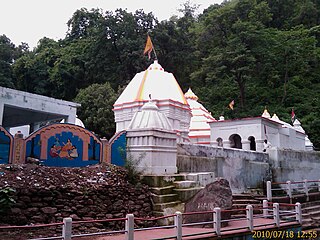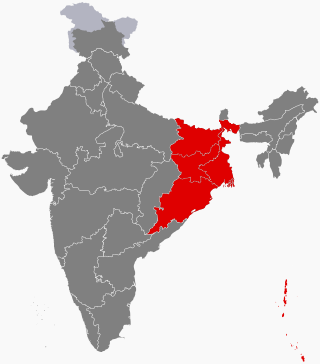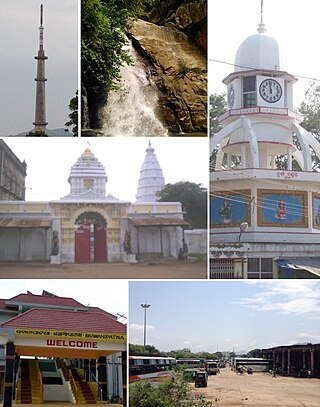
Vijayadashami, also known as Dussehra, Dasara or Dashain, is a major Hindu festival celebrated at the end of Navaratri every year. It is observed on the tenth day in the Hindu calendar month of Ashvin, the seventh month of the Hindu Luni-Solar Calendar, which typically falls in the Gregorian months of September and October.
The folklore of India encompasses the folklore of the nation of India and the Indian subcontinent. India is an ethnically and religiously diverse country. Given this diversity, it is difficult to generalize the vast folklore of India as a unit.

Balangir District, also called Bolangir District, is a district situated in western Odisha state of India. The district has an area of 6,575 km2 (2,539 sq mi), and a population of 1,648,997. The town of Balangir is the district headquarters. The composition of the land is predominantly rural. Other important big & small towns in Balangir district are Titlagarh, Patnagarh, Kantabanji, Loisingha, Saintala, Belpada, Tushra, Agalpur, Deogaon, Chudapali, Biripali, Bhalumunda, Bangomunda, Sindhekela, Turekela and Muribahal.

Kalahandi district is a district of Odisha in India. Archaeological evidence of Stone Age and Iron Age human settlement has been recovered from the region. Asurgarh offered an advanced, well civilised, cultured and urban human settlement about 2000 years ago in the region. In South Asia it is believed that the lands of Kalahandi district and Koraput district were the ancient places where people started cultivation of paddy. In ancient time it was known as Mahakantara and Karunda Mandal, which means treasure of precious stones like karandam (corundum/manik), garnet, beruz, neelam, and alexandrite, etc. Manikeswari is the clan deity of Kalahandi may also signify its historical name.

East India is a region of India consisting of the Indian states of Bihar, Jharkhand, Odisha and West Bengal and also the union territory of the Andaman and Nicobar Islands. The region roughly corresponds to the historical region of Magadha from which it inherits its various Eastern Indo-Aryan languages.

Bhawanipatna is a city and headquarters of the Kalahandi district, in the Indian state of Odisha. Bhawanipatna has numerous temples dedicated to different deities of the Hindu pantheon. It is named after the presiding deity, Bhawani-Shankar and Patna which means "place" in Odia like "Padaa". Bhawanipatna municipality is the administrative head of the city, which is divided into twenty wards with different sub-areas called pada. Originally, these padaas were inhabited by people of different communities, but over the last few decades, these padaas have become homogeneous. Bhawanipatna has more than forty padaas.
The Odia (ଓଡ଼ିଆ), formerly spelled Oriya, is an Indo-Aryan ethnic group native to the Indian state of Odisha who speak Odia language. They constitute a majority in the eastern coastal state, with significant minority populations in neighboring Andhra Pradesh, Chhattisgarh, Jharkhand and West Bengal.

Sarala Dasa was a 15th-century poet and scholar of Odia literature. Best known for three Odia books — Mahabharata, Vilanka Ramayana and Chandi Purana — he was the first scholar to write in Odia and his revered as the Adi Kabi of Odia literature. As an originator of Odia literature, his work has formed an enduring source of information for succeeding generations.

The Maa Sarala Temple is a Hindu temple in the district of Jagatsinghpur, Odisha, India. It is one of the eight most famous Shakta shrines of Odisha.
Odisha is one of the 28 states of India, located in the eastern coast. It is surrounded by the states of West Bengal to the north-east, Jharkhand to the north, Chhattisgarh to the west and north-west, Andhra Pradesh to the south and south-west. Odia is the official and most widely spoken language, spoken by 33.2 million according to the 2001 Census. The modern state of Odisha was established on 1 April 1936, as a province in British India, and consisted predominantly of Odia-speaking regions. April 1 is celebrated as Odisha Day.

Nuakhai is an agricultural festival mainly observed by people of Western Odisha in India. Nuakhai is observed to welcome the new rice of the season. According to the calendar it is observed on panchami tithi of the lunar fortnight of the month of Bhadrapada or Bhadraba (August–September), the day after the Ganesh Chaturthi festival. This is the most important social festival of Western Odisha and adjoining areas of Simdega in Jharkhand, where the culture of Western Odisha is much predominant because there are so many things learn about agriculture with Human behavior also, nuakhai is very big festival and a unique festival also that's why every Indian knowing to Nuakhai History if you love any food then.
Ampani is a town in the Kalahandi district of the state of Odisha, in India. It is a gram panchayat that comes under Kokasara tehsil. It is 15 km from its main town and blocks Kokasara.
The Indian state of Odisha has a rich cultural and artistic heritage. Due to the reign of many different rulers in the past, arts and crafts in Odisha underwent many changes giving an artistic diversity today in the forms of traditional handicrafts, painting and carving, dance and music, clothing, etc.

Odissi music is a genre of classical music in India, originated from the eastern state of Odisha. The traditional ritual music for the service of Lord Jagannatha, Odissi music has a history spanning over two thousand years, authentic sangita-shastras or treatises, unique Ragas & Talas and a distinctive style of rendition.
Sambalpur, in Orissa, India, is a region that has a distinct cultural identity. The songs, clothing, dances, language and festivals celebrated in Sambalpur are unique. This distinct cultural identity arises from the strong association of the tribal and folk communities which have been coexisting in Sambalpur for centuries.
Several folk dance forms evolved in different regions of Odisha, Odissi and Chhau being some popular forms. Sambalpuri dance is most popular dance of western Odisha.
Sarbeswar Bhoi is an Indian folksinger from Kalahandi, India of Sambalpuri folk music. He sang songs such as "Likri Jhkri' and "Lal Jhara Jhara" for the Sambalpuri movie Aadim Vichar, which won National Award for Best Feature Film in Odia Category in 2014.

Dhaneswar Swain is an exponent and Guru of the Odissi Mardala, the traditional percussion instrument of Odissi music. He is known for his rhythmic compositions and fingering techniques, as well as his efforts to promote solo Mardala recitals and group presentations combining traditional percussive instruments of Odisha. He is the founder of Vadya Vani Gurukula, an institution for training and research in Odissi Mardala and other traditional percussion instruments of Odisha.











